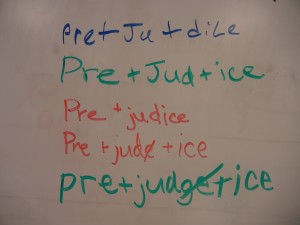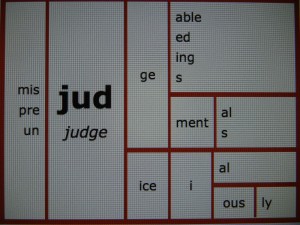Well, I’m back from an intense, yet exhilarating 3 day workshop on Structured Word Inquiry. In the serene setting of Wolfe Island, Canada, Pete Bowers enthusiastically convinced the participants by use of evidence that the language we have been taught to think of as quirky, nonsensical, irregular and incomprehensible, is in fact a well ordered writing system that adheres to rules. Now, these are not rules with exceptions (one thing many of us have been erroneously taught), but rules that do not allow exceptions. It turns out that the English language has structure that we can count on and spellings that we can explain by means of scientific inquiry. How refreshing!
I left the workshop with a better understanding of how to turn word inquiries into focused lessons, as well as how to more effectively use the resources available to me. In other words, my curiosity is super charged! I’m looking forward to the question I can’t answer straight away. I’m looking forward to being part of the search and to listen to students draw conclusions based on evidence gathered. I’m looking forward to my classroom being a place where we celebrate words, their meanings, and our new understandings of their spellings.
With all of that super charged enthusiasm surrounding me, imagine my delight when checking my email upon my return and finding a message from a student. It seems Hailee was writing a story. While writing, she began wondering about the word <especially>. She wondered why the <l> was doubled. She knew that in monosyllablic words that have a single vowel in front of a final consonant, the final consonant is doubled. But she also knew that that was not the case in <especially>.
So … in response to Hailee’s excellent question …
The first thing I did was to think of a word sum hypothesis. I recognize the word <special>, so I can guess that <e> is a clip of <ex> and is a prefix. Besides, that would make sense that if something is referred to as <especially>, it is being pulled “out” as being extra special or being set aside as being extra special.
And because I recognized <special>, I suspect that <ly> might be a suffix. So far my hypothesis is <e> + <special> + <ly>. But then I wondered about <special>. Is that the base, or can I peel off another affix.
At this point I went to etymonline and looked up <especially>. This is what I found:
There’s my proof that <ly> is a suffix. (And that is also a big clue to the answer to Hailee’s question – but I’ll explain better at the end.)
From there I clicked on <especial>.
That gave me an idea that perhaps <special> might not be the base. So then I clicked on <species>.
If you notice, <species> comes from the Latin word <species> and is related to <specere> meaning to look at, to see, behold. (Which also fits with what we think of when we think of something as special! Now, if you remember that Old Grouch taught us that <ere> is a latin suffix, that means the base of <species> and <special> and <especially> is <spec>!
Back to my hypothesis about it’s word sum. I’m going to change it to <e> + <spec> + <ial> + <ly>.
Just to make sure that <ial> is indeed a suffix, I went to Word Searcher and put in <ial$>. Three words I found that have <ial> as a suffix are burial (<bury> + <ial>), facial (<face> + <ial>), and partial ( <part> + <ial>). Since this post, my students and I have done further research and discovered that <ial> is NOT a suffix. The suffix is <al>. The <i> in some words is a connecting vowel. In other words it was once a <y> and has been changed to an <i> before adding an <es> suffix. In other words the <i> is part of the base.
Phrew! Now to answer Hailee’s question about the double <l>. As you can see, there is an <l> in the final position of the suffix <al> and an <l> in the initial position of the suffix <ly>, so the <l> has not been doubled. NOW in a word like stopping, the base is <stop> and the suffix is <ing>, and when we add that suffix, we do indeed double the consonant<p> because of the reason Hailee brilliantly stated in her question. When I sent a reply to Hailee, I also asked her to write word sums and then to create a matrix for the base <spec>. Below is her matrix.
The next wonderful thing that came from all this was that I presented this matrix to my summer school orthography students and asked them to write word sums. Then we had a great discussion about “checking the joins”. That means that when adding suffixes, we may need to apply some suffixing rules and make some spelling adjustments. The students became familiar with the structure of a matrix and how the suffixes are arranged in a particular order to accommodate the spelling of many words.
Thanks Hailee! And keep the questions coming!



